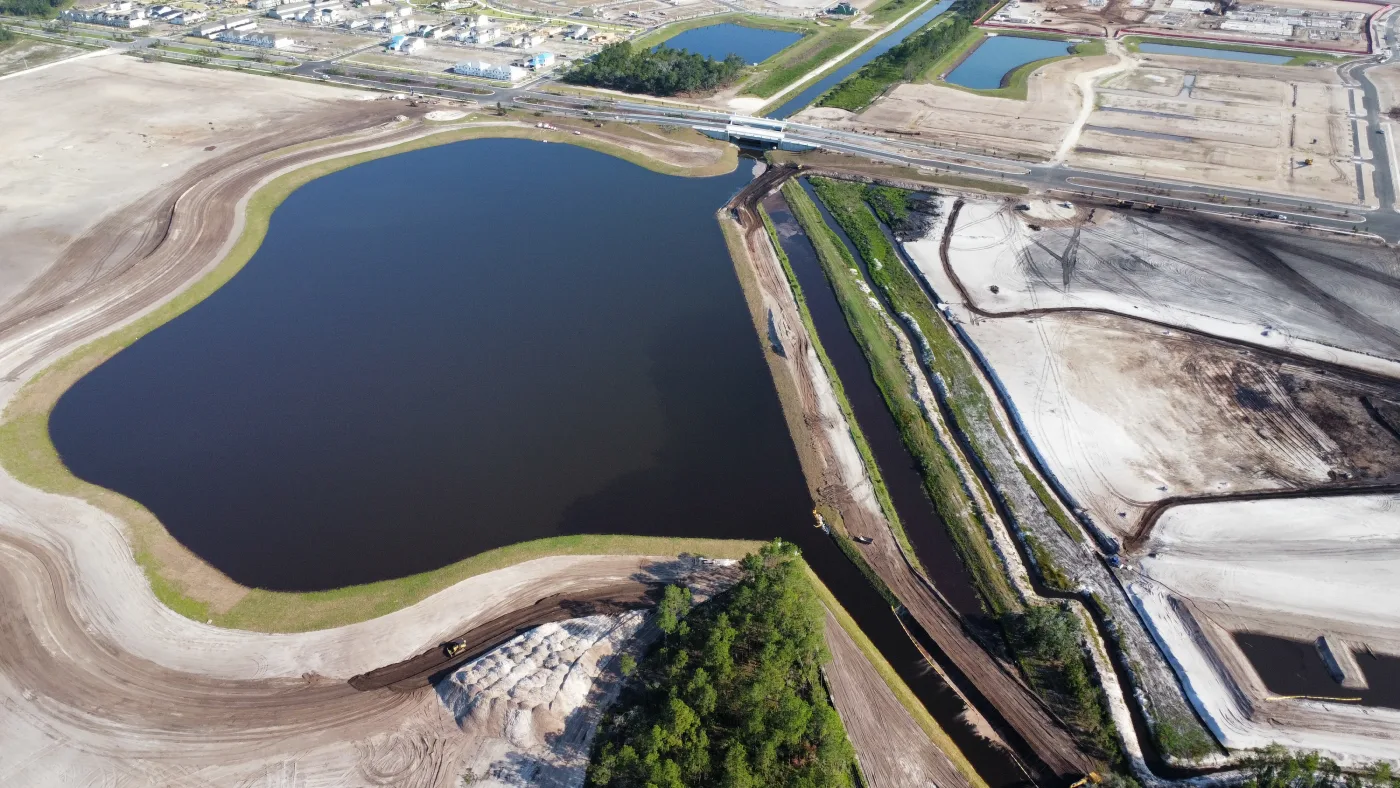Innovative Engineering in Action: The Big Dig That Withstood Hurricane Ian
At some point in the past few years, you’ve likely heard a project was like building an airplane while it’s flying. The cliché is so well known that a beloved advertisement assumes widespread familiarity with it.
Next meeting, try on a new metaphor: excavating a marina basin in line with a preexisting flood control canal while maintaining the canal’s full flow capacity just in case a storm hits, which it does. That became the challenge Poulos & Bennett, a Pape-Dawson Company, faced in 2022.
Poulos & Bennett’s work with the project began in 2017, when they started playing a crucial part in shaping infrastructure at Sunbridge, a Florida development straddling Orlando and the Space Coast. At that point, developers imagined it as a hub of living and work that would combine the area’s natural beauty with a sense of community and modern-day convenience. Since then, the firm has contributed master planning for utilities, drainage, and roadways spanning the development’s 19,560-acre section in Osceola County, which so far includes residential developments of more than 1,000 lots, 15 acres of parks, five miles of new roadway, eight miles of utilities, and two bridges.
Central to the development’s resiliency is the Watershed, a 46-acre manmade lake integrated with a system of canals and other artificial control structures designed to alleviate flooding in this hurricane-prone area. Historical data showed that water levels there could fluctuate as much as 6.7 feet in a year, which would pose a significant impediment to construction and a hazard to homes and businesses. Prudence dictated the engineering to withstand a 100-year storm.
Prudence also required ensuring the process of construction would not degrade the flood control features already in place. “It was hard for anybody to imagine how we would build while maintaining flood control in the canal at all times,” says Jamie Poulos, P.E., LEED AP, Partner at Poulos & Bennett. “In fact, there were a couple of times we heard people say it would be impossible to build.”
The team initially considered bypass canals to help withstand a 100-year flood event. They ruled that option out as infeasible, though, because the bypass would require both an enormous cross section and on-hand pumps to be effective. The team’s answer was a phased approach, engineered to maintain capacity. “For Phase One, we excavated the west side of what we then called the Big Dig and later became known as the Watershed,” explains Poulos & Bennett Team Leader Christy Baxter, P.E.
Excavation began in April 2022. “Everything was going great,” Christy continues, “until September, when Hurricane Ian hit.” The storm’s center moved directly over the Big Dig, unleashing over a foot of rainfall that threatened nearby homes. The district’s executive director called Jamie the weekend after the hurricane moved through the project to ask for Sunbridge’s help. The project with the South Florida Water Management District (SFWMD) successfully activated flood control measures within the site, reversing flow direction from north to south and pumping water away from homes at a rate of over 400 cubic feet per second.
Despite the challenges of a major storm, the project pressed forward—with a community extremely grateful for a four-phase plan that retained the canal’s water carrying capacity. Phase two dug bypass canals to reroute water flow from the original canal into the just-excavated portion of the Big Dig, filling the basin and then disconnecting the original canal.
Phase three completed the marina by excavating its eastern half, just on the other side of the original canal. That left the project with one final task: taking down the large berm that had once been part of the original canal and now bisected the two halves of what would become the Watershed.
That task became the fourth and last phase. Local agencies’ biggest concern was, “How are you going to get that berm out of the middle and not create a big problem?” recalls Christy. The answer: precise, painstaking work. Two excavators reduced it in wet conditions, starting at the center of the berm and slowly working away from each other, backing up to the shore.

By the time construction wrapped up in 2024, approximately 1.3 million cubic yards came out of the Big Dig. Not only is the amount of dirt sizeable, so is the project’s impact on the area. Now known officially as the Watershed, it provides 150 acre-feet of floodplain storage to protect nearby homeowners and businesses when the next storm hits. But that’s far from its only benefit, says Jamie. “For the developers, this is the jewel of the 19,000-acre community. It will anchor restaurants, gathering spaces, and other amenities.”
Building an airplane while it’s airborne? So 2010.
Digging a marina basin around a working canal—during the sort of hurricane the canal was built for? Now that’s impressive…and just maybe the work cliché of the 2020s.
